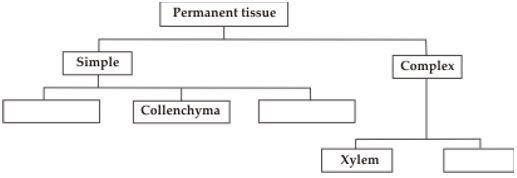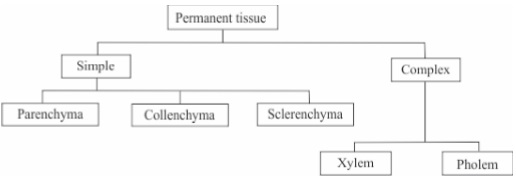Tissues - NCERT - NCERT Questions
Define the term “tissue”
SOLUTION:Group of cells which are similar in structure that work together to achieve a particular function forms a tissue.
Q 2.How many types of elements together make up the xylem tissue? Name them
SOLUTION: Four types of elements together make up the xylem tissue. These elements are–
(A) tracheids,
(B) vessels,
(C) xylem parenchyma and
(D) xylem fibres.
How are simple tissues different from complex tissues in plants?
SOLUTION:Simple tissues are made up of only one type of cells, which look like each other. On the other hand, complex tissues are made up of more than one type of cells. Parenchyma, collenchyma and sclerenchyma are the examples of simple plant tissue whereas xylem and phloem are complex tissue.
Q 4.Differentiate between parenchyma, collenchyma and sclerenchyma on the basis of their cell wall
SOLUTION: On the basis of the cell wall, differences between parenchyma, collenchyma and sclerenchyma are–
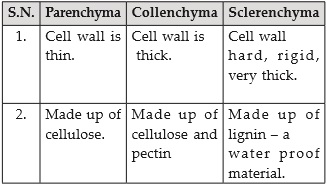
What are the functions of stomata?
SOLUTION:Stomata are necessary for exchanging gases with the atmosphere. Transpiration (loss of water in the form of water vapour) also takes place through stomata.
Q 6.Diagrammatically show the difference among three types of muscle fibres
SOLUTION: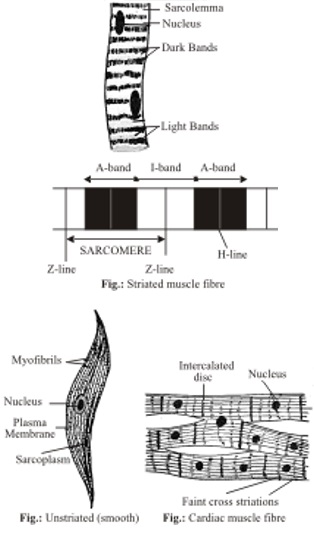
What is the specific function of the cardiac muscle?
SOLUTION:The specific function of the cardiac muscle is rhythmic contraction and relaxation simultaneously throughout life without getting fatigued.
Q 8.Differentiate among striated, unstriated and cardiac muscles on the basis of their structure and site/location in the body
SOLUTION:The differences among striated, unstriated and cardiac muscles are as follows:
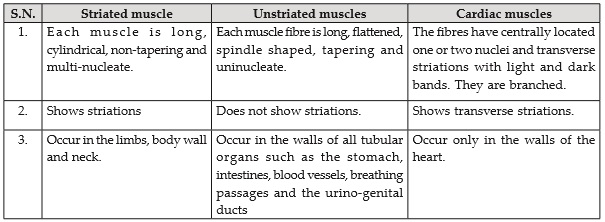
Draw a labelled diagram of a neuron
SOLUTION: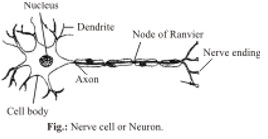
Name the following:
(A) Tissue that forms inner lining of our mouth.
(B) Tissue that connects muscle to bone in humans.
(C) Tissue that transports food in plants.
(D) Tissue that stores fat in our body.
(E) Connective tissue whose matrix is fluid.
(F) Tissue present in the brain.
(A) Epithelial tissue—Squamous epithelium,
(B) Tendon,
(C) Phloem,
(D) Adipose tissue,
(E) Fluid connective tissue — Blood,
(F) Nervous tissue.
Identify the type of tissue in the following: skin, bark of tree, bone, lining of kidney tubule, vascular bundle
SOLUTION: Skin—Squamous epithelium
Bark of tree—Epidermal tissue/cork
Bone—Supportive connective tissue/skeletal tissue
Lining of kidney tubule—Ciliated epithelium
Vascular bundle—Xylem and phloem (conducting tissue).
Name the regions in which parenchyma tissue is present
SOLUTION:In small herbaceous plants, parenchyma makes up the bulk of the plant body. It is mainly found in the cortex, pith, ground tissue of petioles, mesophyll of leaves and also in vascular bundles.
Q 13.What is the role of epidermis in plants?
SOLUTION:It protects internal tissues against mechanical injury, parasitic fungi, bacteria, and also cold or heat. Thick cuticle, wax, epidermal hair and multiple epidermis reduce loss of water from internal tissue. Epidermal cells of roots have hairs that greatly increase the absorptive surface areas for the absorption of water and nutrients.
Q 14.How does the cork act as a protective tissue?
SOLUTION:The walls of cork cells are heavily thickened by the deposition of suberin. This structural characteristic helps the cork to protect and prevent from infection and mechanical injury. It also prevents desiccation, by preventing loss of water from the plant body.
Q 15. Complete the table:
